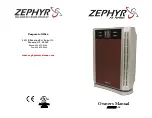
- 9 -
[3] Check the symptoms of the unit requiring service.
Refer to this service manual for problems related to Freezer Cycle.
[4] Be sure to read
Read Before Servicing
at the beginning of this manual.
[5] Prepare necessary tools.
Do not use the same tools for units that use different types of refrigerant (especially gauze manifold and
charge hose). Doing so may cause problems. Use a vacuum pump with a reverse-flow check valve or use a
reverse flow check adapter.
[6] If the refrigerant circuit is opened (to repair gas leak etc.), the drier needs to be
replaced.
Only use the drier designed specifically for the unit. The use of other driers may result in malfunctions. Refer to
section 11 of this manual for information regarding how to change the drier.
✻
Replace the drier after completing refrigerant circuit repairs.
(If left exposed to air, the drier will absorb moisture. Replace the drier as quickly as possible after removing
the old one.)
[7] Preparing the connecting pipes: When relocating or replacing the unit, find out what
types of refrigerant is used for the unit.
Use refrigerant pipes made of C1220 phosphorus deoxidized copper categorized under H3000 (Copper and
Copper Alloy Seamless Pipes and Tubes), a standard set by JIS. Keep inner and outer surfaces of the pipes
clean and free of contaminants, such as sulfur, oxides, dust/dirt, shaving particles, oils, and moisture.
Contaminants inside the refrigerant piping will deteriorate the refrigerant oil.
[8] If there is a gas leak or if the remaining refrigerant is exposed to an open flame, a
noxious gas hydrofluoric acid may form. Provide adequate ventilation.
.
Caution
1. As soon as the old parts are removed, put in the new ones. Keep moisture from entering pipes while cooling.
2. Using refrigerant containing chlorine (such as R22) will result in the deterioration of oil in the new unit.











































